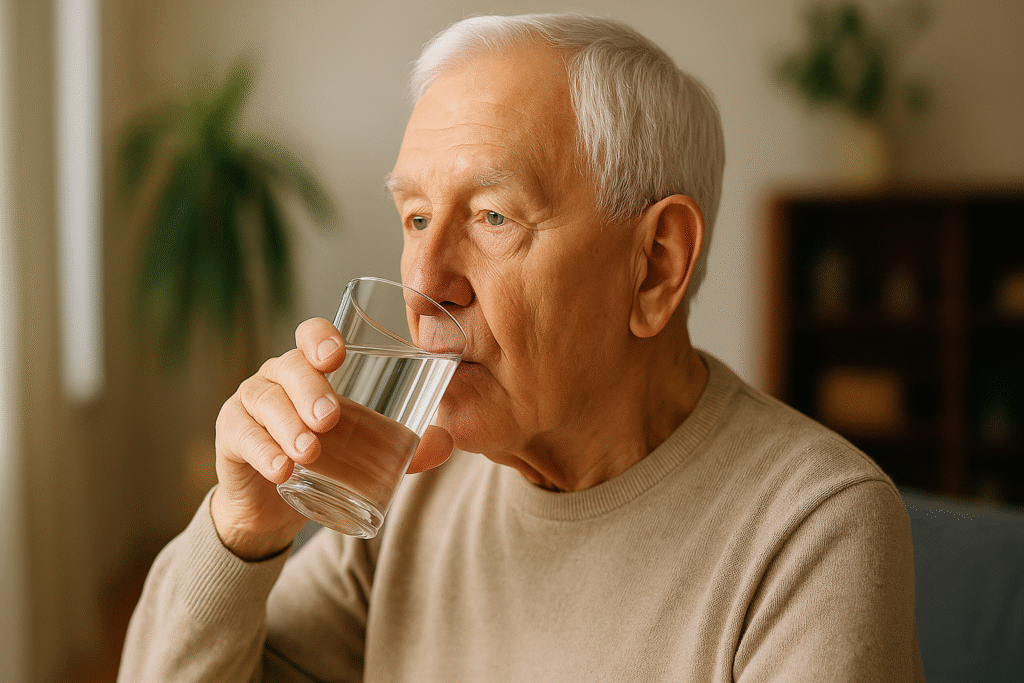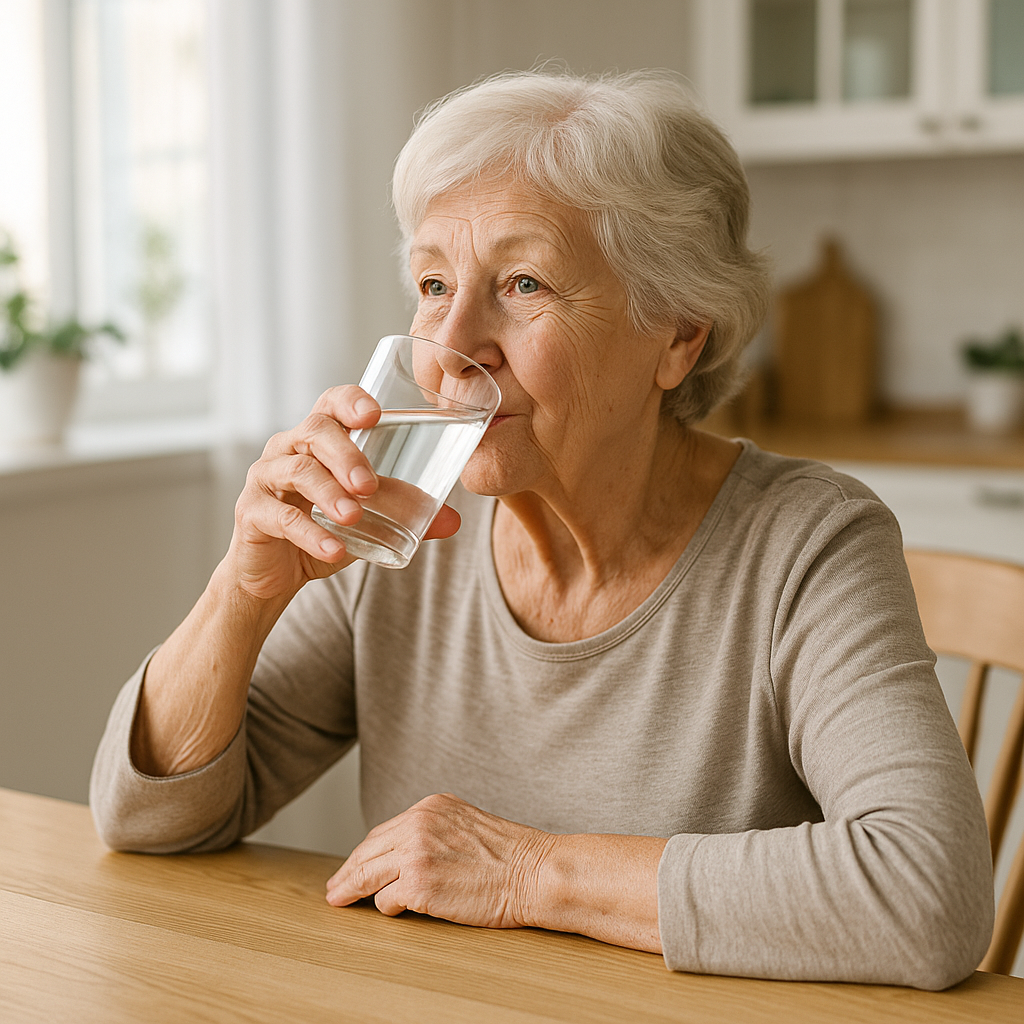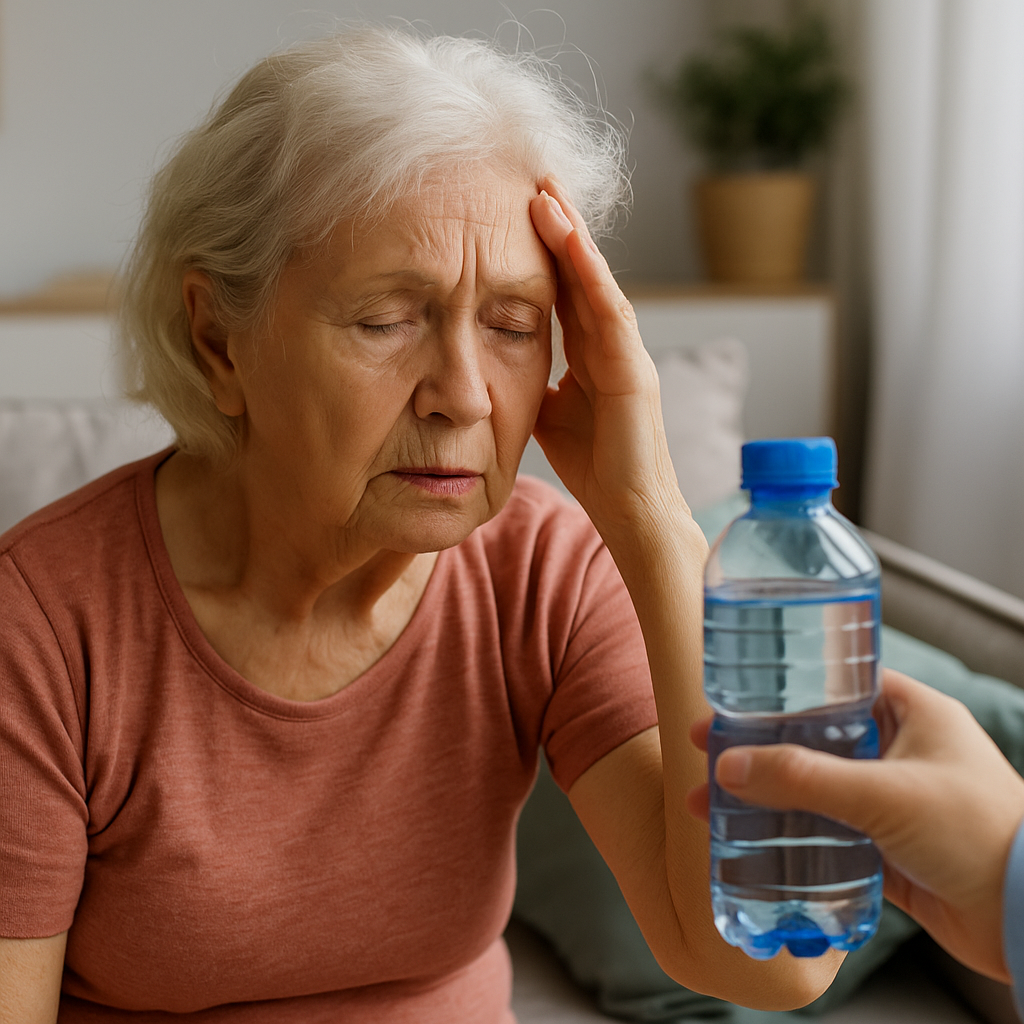
Introduction
Hydration for seniors is one of the simplest yet most powerful health habits for maintaining independence and vitality. As we age, the body’s ability to sense thirst, regulate temperature, and conserve water naturally diminishes. Even mild dehydration can cause fatigue, confusion, and balance problems that increase fall risk.
As a wound-care and functional-medicine physician, I’ve seen how consistent hydration improves cognition, circulation, and healing in my older patients. This guide explains why hydration for seniors is medically vital, how dehydration affects multiple body systems, and evidence-based strategies to help older adults stay hydrated and healthy.
Why Hydration Matters More as We Age

Water supports every essential function—circulation, digestion, waste removal, temperature regulation, and nutrient transport. But maintaining hydration becomes harder with age due to physiologic and lifestyle factors.
1. Reduced thirst sensitivity
The brain’s “thirst center” becomes less responsive over time. Seniors often don’t feel thirsty until they are already dehydrated.
2. Changes in body composition
Muscle holds water. As muscle mass decreases and fat increases, total body water may drop from ≈ 60 % in youth to ≈ 45 % in older adults, leaving less reserve during illness or heat.
3. Medications and chronic conditions
Diuretics, laxatives, and some antidepressants promote fluid loss, while illnesses like diabetes or dementia disrupt fluid regulation.
4. Kidney efficiency declines
Aging kidneys cannot concentrate urine as effectively, so the body loses more water. According to the National Institute on Aging, even mild dehydration increases the risk of urinary-tract infections and confusion.
5. Environmental and behavioral factors
Limited mobility, fear of incontinence, or simple lack of nearby drinks all reduce fluid intake.
In short: hydration for seniors isn’t optional—it’s a foundation for cardiovascular stability, skin integrity, and mental clarity.
Understanding Fluid Balance in the Aging Body
The body keeps water levels in balance through a partnership between the brain, kidneys, and heart.
When you lose fluid, the brain detects that your blood has become more concentrated and sends a signal to drink. It also tells the kidneys to conserve water by making urine less concentrated.
In older adults, this “hydration alarm” becomes sluggish, so thirst and kidney responses lag behind the body’s needs.
Think of it like a thermostat that reacts slowly—the temperature drifts too high before the cooling system kicks in. Similarly, seniors may remain dehydrated longer after heat, illness, or diuretic use.
A well-hydrated senior maintains steadier blood pressure, smoother temperature control, and better balance—three critical defenses against falls.
Signs and Risks of Dehydration in Seniors

Dehydration doesn’t always present dramatically. It often begins with subtle clues:
- Early: dry mouth, fatigue, irritability, constipation.
- Later: confusion, dizziness, rapid pulse, or decreased urine output.
In my own practice, one woman was thought to have cognitive decline, but her confusion resolved within days once her hydration was corrected.
Functional impact
Dehydration lowers blood volume and can cause lightheadedness when standing. Proper hydration for seniors directly reduces fall risk—something discussed in detail in Understanding Fall Risks in Seniors and How to Prevent Them.
Skin and wound effects
Water keeps the skin flexible and nourished. Dry tissue tears easily and heals slowly. Maintaining hydration for seniors protects the skin and complements prevention strategies outlined in How to Prevent Pressure Ulcers (Bedsores) in Seniors: A Complete 2025 Guide.
Medical emergencies
The CDC reports that adults 65 + account for nearly half of all heat-related hospitalizations. Dehydration also concentrates medications, increasing side-effect risk.
How Much Water Do Seniors Need?
The “eight-glasses-a-day” rule is a rough guide. A better formula is ≈ 30 mL per kg of body weight daily, about 1.5–2 L (6–8 cups) for most adults.
Increase intake during heat, exercise, or illness, and decrease only if a doctor prescribes fluid restriction.
Example:
A 78-year-old woman with leg ulcers drank less than 1 liter daily. Once she added 250 mL with each medication round, her blood pressure stabilized and her wound began healing.
Hydration sources go beyond water—soups, smoothies, herbal tea, and water-rich fruits all count. For broader nutrition context, see Nutrition for Elderly (2025 Guide to Healthy Aging & Mobility Support).
Best Hydration Strategies for Seniors
1. Pair hydration with daily habits
Link drinking to medications or meals. Label bottles “Morning,” “Noon,” “Evening” for visual cues.
2. Use adaptive cups or bottles
Light, easy-grip designs prevent spills. For bedbound adults, long-straw cups or hydration backpacks make access effortless.
3. Add flavor and temperature variety
Infuse water with lemon, cucumber, or mint; alternate warm and cold drinks for comfort through the seasons.
4. Include hydrating foods
Soups, yogurt, and smoothies supply fluids and nutrients together. Frozen fruit pops can encourage reluctant drinkers.
5. Keep fluids within reach
Reduce tripping hazards and place water near favorite seats—tips also found in Tips for Making Your Home Safer for Seniors.
6. Track output
Urine that’s pale yellow is ideal; dark or strong-smelling urine signals dehydration.
Case insight:
A Parkinson’s patient began keeping a small “hydration basket” beside his chair with bottled water and electrolyte packets. His alertness and digestion improved within a week.
Best Times of Day to Hydrate
Spacing fluids evenly avoids overload:
| Time | Purpose |
|---|---|
| Morning | One cup upon waking to restart circulation |
| Mid-morning | Replaces fluids lost to caffeine |
| Lunch | Supports digestion and nutrient absorption |
| Afternoon | Prepares for exercise or outdoor time |
| Evening | Light sips an hour before bed to avoid night-time trips |
Routine schedules help seniors with memory issues maintain steady hydration without relying on thirst cues.
Hydration and Wound Healing
In wound-care medicine, hydration is as critical as nutrition. Water sustains blood flow, nutrient delivery, and tissue repair.
How proper hydration aids healing
- Blood flow: Adequate volume keeps oxygen and nutrients reaching wounds.
- Collagen formation: Cells need water to build and crosslink new tissue.
- Inflammation control: Balanced hydration minimizes swelling and tissue stress.
- Immune strength: Hydrated tissue defends better against infection.
Case study:
A 72-year-old with diabetes and an ankle ulcer increased her intake by 500 mL/day; within a month, the wound depth halved.
Hydration for seniors works hand-in-hand with protein intake, explored further in Protein for Elderly: Daily Requirements & Tips for Seniors (2025 Guide).
Beyond wound repair, hydration influences nearly every organ system — particularly the brain and heart.
Cognitive and Cardiovascular Benefits
Even mild dehydration (1–2 %) slows reaction time and memory. Adequate fluid intake improves focus, mood, and mental sharpness.
Cardiovascularly, water maintains blood volume and smooth heart rhythm. Dehydration thickens blood and raises clot risk in vulnerable seniors.
In one facility, adding morning hydration rounds cut orthostatic-dizziness incidents nearly in half within six months—a simple fix with measurable gains.
Common Myths About Hydration
Myth 1: Thirst means you’re dehydrated enough to drink.
Reality: thirst lags behind need; drink before you feel parched.
Myth 2: Clear urine equals perfect hydration.
Overhydration can dilute sodium, causing weakness or confusion.
Myth 3: Coffee and tea don’t count.
They still provide net fluid; just balance with water.
Myth 4: Only water matters.
Hydrating foods—soups, fruits, yogurt—also sustain fluid balance.
Sustainable hydration comes from variety, not rigid rules.
When to Seek Medical Care
Contact a clinician if dehydration persists despite drinking or if accompanied by fever, vomiting, diarrhea, or confusion.
Doctors confirm dehydration through simple labs (e.g., elevated sodium or BUN/creatinine ratio > 20:1).
The Cleveland Clinic recommends evaluation for recurring dehydration—often a sign of medication effects, kidney disease, or swallowing issues.
Caregiver Tips for Tracking Hydration

- Visual reminders: Colored cups or progress markings.
- Offer choice: Rotate flavors and beverages.
- Record intake: Use a simple log or chart.
- Coordinate with meals: Pair fluids with snacks to encourage balance.
- Leverage tech: Smart bottles and phone reminders prompt consistency.
Small, structured systems turn hydration from a task into a daily routine of self-care.
FAQs — Hydration for Seniors
1. How much should seniors drink daily?
Usually 6–8 cups (1.5–2 L), adjusted for body weight and medical conditions.
2. What drinks hydrate best?
Water first; add herbal teas, broth, or milk. Low-sugar electrolyte drinks help during illness or heat.
3. How can caregivers boost hydration for seniors who resist drinking?
Tie fluids to medication times, add flavor, or make drinking social—tea breaks and smoothies count.
4. How does dehydration affect mood and thinking?
Even small deficits cause irritability and confusion. Rehydration often restores alertness within hours.
5. Can seniors drink too much water?
Yes—excess intake without electrolytes can lower sodium (hyponatremia). Moderation matters.
6. Do foods count toward hydration goals?
Absolutely. Fruits and soups provide both fluids and nutrients.
7. How does hydration affect medication safety?
Water aids absorption and prevents drug buildup. Dehydration can intensify side effects.
Final Thoughts — Staying Hydrated, Healthy, and Independent
Hydration for seniors is one of the simplest habits with the biggest payoff.
Regular fluid intake sharpens cognition, strengthens balance, supports wound healing, and lowers hospitalization risk.
Start small: a morning glass, an afternoon refill, a nightly tea.
Build reliable hydration habits now—before your body demands them.
For additional nutrition insight, revisit Nutrition for Elderly (2025 Guide to Healthy Aging & Mobility Support).
Medical Disclaimer
This content is for educational purposes only and not a substitute for medical advice, diagnosis, or treatment. Always consult your physician regarding personal health conditions.
